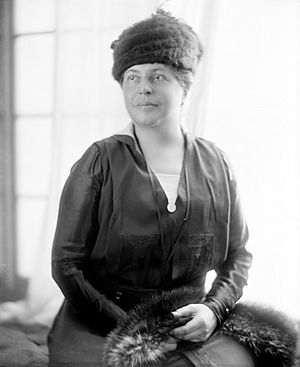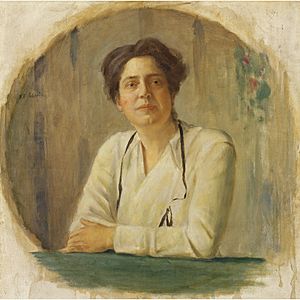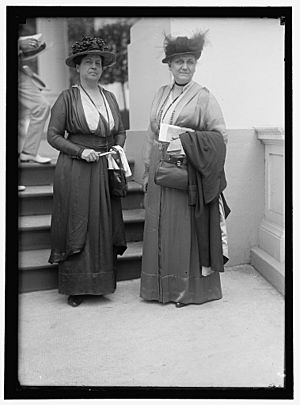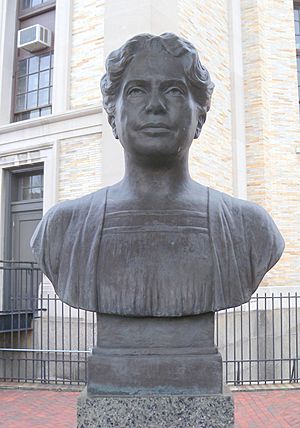Lillian Wald facts for kids
Quick facts for kids
Lillian Wald
|
|
|---|---|

Harris & Ewing/LOC hec.19537. Miss Lillian Wald, between 1905 and 1945
|
|
| Born | March 10, 1867 Cincinnati, Ohio, U.S.
|
| Died | September 1, 1940 (aged 73) Westport, Connecticut, U.S.
|
| Resting place | Mount Hope Cemetery Rochester, New York, U.S. |
| Alma mater | New York Hospital Training School for Nurses |
| Occupation | Nurse, humanitarian, activist |
| Known for | Founding the Henry Street Settlement; nursing pioneer, advocacy for the poor |
Lillian D. Wald (born March 10, 1867 – died September 1, 1940) was an American nurse, a kind helper, and a writer. She is famous for her work in human rights and for starting community nursing in America. She created the Henry Street Settlement in New York City. She also pushed for nurses to be in public schools.
Lillian grew up in Ohio and New York. She became a nurse and even went to medical school for a short time. She started teaching health classes in communities. After she founded the Henry Street Settlement, she became a strong voice for the rights of women and minority groups. She supported women's right to vote and worked for racial equality. She also helped start the National Association for the Advancement of Colored People (NAACP).
Lillian Wald passed away in 1940 when she was 73 years old.
Contents
Early Life and Education
Lillian Wald was born into a wealthy family in Cincinnati, Ohio. Her parents were Max D. Wald and Minnie (Schwarz) Wald. In 1878, her family moved to Rochester, New York. She went to a special boarding school for young ladies. When she was 16, she tried to get into Vassar College, but they thought she was too young. In 1889, she went to New York Hospital's School of Nursing. She finished her nursing studies in 1891. After that, she took more classes at the Woman's Medical College.
Lillian Wald's Nursing Career
Lillian Wald first worked at an orphanage called the New York Juvenile Asylum. The conditions there were not good. By 1893, she left medical school. She began teaching nursing classes at home for poor immigrant families. These families lived on New York City's Lower East Side. Soon after, she started visiting sick people in their homes to care for them.
Lillian and another nurse, Mary Brewster, moved into a simple room close to their patients. This helped them care for people better. Around this time, Lillian Wald created the term "public health nurse." This described nurses who work directly within a community.
Lillian Wald strongly believed that nurses should be in public schools. Her ideas led New York City to create the world's first public nursing system. She became the first president of the National Organization for Public Health Nursing. Lillian also started a nursing insurance plan with the Metropolitan Life Insurance Company. This plan became a model for many other companies. She even suggested a national health insurance plan for the whole country. She also helped to start the Columbia University School of Nursing. Lillian Wald wrote two books about her community health work: The House on Henry Street (1911) and Windows on Henry Street (1934).
Founding the Henry Street Settlement
Lillian Wald founded the Henry Street Settlement. This organization caught the eye of a rich helper named Jacob Schiff. He secretly gave Lillian money to help the "poor Russian Jews" she was caring for. By 1906, Lillian Wald had 27 nurses working for her. She also got more financial help from other wealthy people like Elizabeth Milbank Anderson. By 1913, her staff had grown to 92 people. The Henry Street Settlement later became known as the Visiting Nurse Service of New York.
Henry Street's Vision and Benefits
Lillian Wald had a special vision for the Henry Street Settlement. She believed that everyone in New York City deserved fair and equal healthcare. This was true no matter their social status, wealth, race, gender, or age. She argued that everyone should have access to at-home-care. Lillian also believed that all people should be treated with respect, even if they could not afford care.
The Settlement brought many important changes to public health. It did more than just provide better medical care. It focused mainly on helping women and children. The programs helped reduce the time patients spent in hospitals. They also made at-home-care easier to get and more effective.
Lillian Wald strongly believed in community support. Much of the Henry Street Settlement's early success came from her hard work. She built strong relationships with the people who donated money. Lillian also thought it was good to have donors who lived in the community. The Settlement helped families stay together by offering care at home. This meant people did not have to go to the hospital as often. It also lowered medical costs by providing an alternative to hospital stays.
Jobs for Women
The Henry Street Settlement gave women a special chance to find jobs. In her letters, Lillian Wald talked to donors about the job opportunities for women. She also explained the many benefits these jobs offered. One big benefit was that women could have a career and earn their own money. This meant they could be independent from their husbands or families. Working outside the home also gave women more freedom.
Community Work and Activism

Lillian Wald also taught women how to cook and sew. She organized fun activities for families. She was also involved in the labor movement, which worked for better conditions for workers. Because she cared about women's working conditions, she helped start the Women's Trade Union League in 1903. Later, she was on the executive committee of the New York City League. In 1910, Lillian and some friends went on a six-month trip. They visited Hawaii, Japan, China, and Russia. This trip made her more involved in helping people around the world.
In 1915, Lillian Wald founded the Henry Street Neighborhood Playhouse. She was also an early leader of the Child Labor Committee. This group later became the National Child Labor Committee (NCLC). The NCLC worked to create federal laws against child labor. They also promoted education for children. In the 1920s, the group suggested a change to the U.S. Constitution to ban child labor. In the 1920s, Lillian Wald strongly supported the social welfare plans of New York Governor Al Smith. In 1928, she actively supported Smith's campaign to become president.
Lillian Wald also cared deeply about how African Americans were treated. As a civil rights activist, she made sure that all Henry Street classes were open to people of all races. In 1909, she became one of the founding members of the National Association for the Advancement of Colored People (NAACP). The NAACP's first big public meeting was held at the Henry Street Settlement.
Lillian Wald organized campaigns in New York City for women's right to vote. She marched to protest the United States joining World War I. She joined the Woman's Peace Party and helped create the Women's International League for Peace and Freedom. In 1915, she was chosen as president of the new American Union Against Militarism (AUAM). She stayed involved with groups that came from the AUAM, like the Foreign Policy Organization and the American Civil Liberties Union. This was even after the United States joined the war.
Personal Life
Lillian Wald never got married. Her closest friends were women. Letters show that Lillian felt very close to at least two of her companions: writer Mabel Hyde Kittredge and lawyer Helen Arthur. However, Lillian was always more focused on her work at Henry Street than on any relationship. She valued her independence. This allowed her to move quickly, travel freely, and act boldly. Her dedication to the Settlement and improving public health was clear in her life.
Later Life and Legacy
Lillian Wald passed away on September 1, 1940, from a brain hemorrhage. A memorial service was held at Henry Street's Neighborhood Playhouse. A private service also took place at her home. A few months later, over 2,000 people gathered at Carnegie Hall to honor Lillian. Messages were read from the president, the governor, and the mayor. She was buried at Mount Hope Cemetery in Rochester.
The New York Times newspaper named Lillian Wald one of the 12 greatest living American women in 1922. She later received the Lincoln Medallion for being an "Outstanding Citizen of New York." In 1937, during a radio show celebrating Lillian's 70th birthday, Sara Delano Roosevelt read a letter from her son, President Franklin Roosevelt. In the letter, he praised Lillian Wald for her "unselfish labor to promote the happiness and well being of others."
Author Helen Dore Boylston wrote about Lillian Wald and Henry Street in her novel Sue Barton, Visiting Nurse (1938). In the book, the character Sue Barton meets Lillian Wald at the Henry Street Settlement.
Lillian Wald was chosen for the Hall of Fame for Great Americans in 1970. In 1993, she was added to the National Women's Hall of Fame. The Lillian Wald Houses in Manhattan were named after her.
Lillian Wald opened doors for women in public health in many ways. She was a medical provider, an employer, and an educator. Her important work can still be seen today in the Visiting Nurses Service of New York.
Images for kids
-
Portrait of Lillian Wald by William Valentine Schevill, National Portrait Gallery in Washington, D.C.
See also
 In Spanish: Lillian Wald para niños
In Spanish: Lillian Wald para niños









